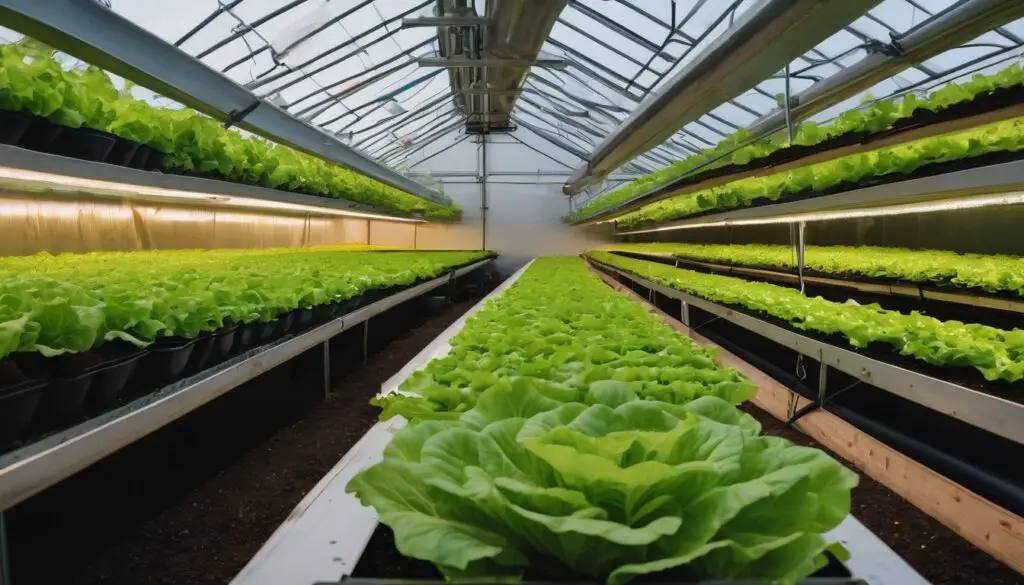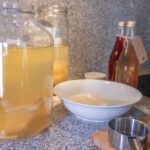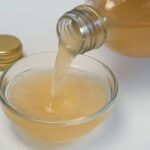Did you realize that using aquaponics for lettuce can result in rapid growth, minimal pest issues, and nutrient-rich produce? This guide will walk you through the best practices for successfully growing vibrant, pest-resistant, and healthy lettuce in an aquaponics environment.
Keep reading to discover a more sustainable way to grow healthy and tasty greens!
Key Takeaways
- Aquaponics systems provide a sustainable and efficient way to grow lettuce, offering benefits like faster growth, higher yields, reduced water consumption, and natural pest control.
- Methods of growing lettuce in aquaponics include floating raft or deep water culture (DWC) systems, media beds, and nutrient film technique (NFT) systems.
- To successfully grow lettuce in aquaponics, follow steps such as germinating seeds, transplanting seedlings into the system, maintaining proper water and nutrient levels, and harvesting when leaves have reached desired size.
- Recommended lettuce varieties for aquaponics include Iceberg (crisphead), Butterhead, Romaine, and Loose Leaf lettuce. These varieties offer different flavors and characteristics suitable for aquaponic cultivation.
If you’re curious about which plants are ideal for your aquaponics system, our comprehensive guide on the best plants for aquaponics is a must-read
Benefits of Growing Lettuce in Aquaponics

Growing lettuce in aquaponics offers several benefits, including faster growth and shorter harvesting time, higher yields, reduced water consumption, and natural pest control.
Faster growth and shorter harvesting time

Lettuce grows fast in aquaponics. You can pick it just after 4 to 5 weeks. It is faster than soil growing. This quick growth gives you a lot of fresh lettuce in a short time. Many heads of lettuce can be grown and picked in the same spot all year long!
Higher yields

Growing lettuce in aquaponics can result in higher yields compared to traditional farming methods. Aquaponic systems provide an optimal environment for lettuce to flourish, resulting in faster and more abundant growth.
With the right balance of nutrients, lighting, and water management, aquaponics can maximize the productivity of your lettuce crops. Studies have shown that aquaponics can produce up to four times the amount of lettuce compared to conventional soil-based farming.
This means you can enjoy a bountiful harvest of fresh and nutritious lettuce all year round with less effort and resources.
Reduced water consumption

Aquaponics offers a sustainable solution for lettuce farming with its reduced water consumption
. In this system, the water is continuously recirculated between the fish tank and the plant beds, minimizing wastage.Compared to traditional farming methods, aquaponics uses 90% less water because it allows plants to absorb nutrients directly from the nutrient-rich fish waste in the water instead of relying on soil.
This efficient use of water helps conserve this precious resource while still ensuring optimal growth for lettuce plants.
Natural pest control

Aquaponics systems have a natural way of controlling pests, which is great for lettuce farmers. The combination of fish and plants creates a balanced ecosystem where beneficial insects thrive and feed on harmful pests.
Ladybugs, lacewings, and predatory mites are examples of useful insects that can help control aphids, whiteflies, and other common garden pests. By relying on nature’s pest control mechanisms, aquaponics reduces the need for harmful pesticides and keeps lettuce crops healthier.
Methods of Growing Lettuce in Aquaponics

There are various methods of growing lettuce in aquaponics, including floating raft or deep water culture (DWC) systems, media beds, and nutrient film technique (NFT) systems. Read on to discover the most suitable method for your lettuce cultivation.
Floating Raft or Deep Water Culture (DWC) system
-system-bed9db5d25-895970479.jpg)
The Floating Raft or Deep Water Culture (DWC) system is a popular method for growing lettuce in aquaponics. In this system, plant roots are suspended in water, allowing them to directly access the nutrients from fish waste.
A floating raft made of polystyrene foam holds the plants on the surface of the water.
This setup provides excellent support for lettuce growth and allows for efficient nutrient uptake. The constant exposure to water enables faster growth rates and higher yields.compared to traditional soil-based methods.
Media beds

Media beds are a popular method for growing lettuce in aquaponics. In this system, plants are placed on top of specially designed beds filled with a medium like gravel or expanded clay pellets.
The water from the fish tank is pumped into these beds, allowing the plants to absorb nutrients from the water while also being supported by the media. This setup provides excellent root support and encourages healthy plant growth.
It also helps to filter out any solid waste produced by the fish, keeping the system clean and balanced. Lettuce grown in media beds can thrive and produce high yields while benefiting from the symbiotic relationship between fish and plants in aquaponics.
Nutrient Film Technique (NFT) system
-system-a419dcff0a-259511334.jpg)
The Nutrient Film Technique (NFT) system is a popular method for growing lettuce in aquaponics. In this system, a thin film of nutrient-rich water flows through channels where the lettuce roots are suspended.
The plants absorb the necessary nutrients while also getting oxygen from the air. This continuous flow of water allows for efficient nutrient delivery and helps prevent diseases caused by stagnant water.
The NFT system is known for its water-saving capabilities and can produce high yields of healthy and flavorful lettuce.
Steps for Growing Lettuce in Aquaponics

Germinate lettuce seeds according to package instructions, transplant seedlings into the aquaponics system once they have developed true leaves, maintain proper water and nutrient levels, and harvest lettuce when leaves have reached desired size.
Lettuce germination

Lettuce germination is the process of lettuce seeds sprouting and growing into seedlings. It typically takes about 3 to 7 days for lettuce seeds to germinate in temperatures between 55 to 70 degrees Fahrenheit (13 to 21 degrees Celsius).
During this time, the seeds draw in moisture from their surroundings, causing them to swell and break open. Once the seed coat splits, a small root emerges first, followed by tiny green leaves.
This is an important stage in lettuce cultivation as it marks the beginning of plant growth. With aquaponics, where plants are grown using nutrient-rich water from fish tanks, lettuce germination can occur faster due to optimal growing conditions and available nutrients.
Transplanting seedlings

To transplant seedlings in aquaponics, gently remove the lettuce seedlings from their initial germination container. Carefully separate the roots and place each seedling into the growing medium of your chosen aquaponics system, such as a floating raft or media bed.
Ensure that the roots are fully covered and supported by the growing medium to promote healthy growth. Take care not to damage the delicate roots during transplantation. Once all seedlings are transplanted, provide them with adequate light, water, and nutrients to continue their development.
Remember to monitor and maintain optimal conditions for your lettuce crop throughout its growth cycle.
General maintenance

To keep your aquaponic lettuce thriving, there are a few general maintenance tasks you’ll need to do regularly. First, check the pH levels of the water to ensure they’re in the optimal range of 6.0 to 7.0 for lettuce growth.
You can use a pH testing kit to monitor this. Next, make sure your lighting and temperature settings are appropriate for lettuce cultivation, aiming for temperatures between 55 and 70 degrees Fahrenheit (13-21 degrees Celsius).
Additionally, maintain a balanced nutrient composition in the water by regularly monitoring and adjusting as needed. Be vigilant against pests by implementing preventive measures like regular system inspections and using organic pest control methods if necessary.
Harvesting
Harvesting lettuce grown in aquaponics is an exciting and rewarding process. Once the lettuce has reached maturity, which can be as little as 4-5 weeks for some varieties, it’s time to harvest and enjoy your homegrown greens.
To harvest, simply cut off the outer leaves of the lettuce with a pair of clean scissors or a sharp knife, leaving the center intact so that new leaves can continue to grow. Aquaponic lettuce tends to have a longer shelf life compared to store-bought varieties since it is harvested fresh and consumed immediately.
Remember to rinse the harvested leaves thoroughly before enjoying them in salads or sandwiches for maximum freshness and flavor. So go ahead and reap the fruits of your aquaponic labor by harvesting delicious and nutritious lettuce from your system!
Recommended Lettuce Varieties for Aquaponics

Iceberg, Butterhead, Romaine, and Loose Leaf lettuce are some of the recommended varieties for aquaponics. Discover the best options to grow in your system and improve your lettuce cultivation.
Iceberg (crisphead) lettuce
Iceberg lettuce is a popular variety for growing in aquaponics systems. It takes longer to mature compared to other lettuce types, usually around 90 days. However, the wait is worth it as iceberg lettuce grown in aquaponic environments tends to be more nutrient-rich and flavorful.
This type of lettuce forms tight heads with crisp leaves that are perfect for salads and sandwiches. With the combination of aquaculture and hydroponics, cultivating iceberg lettuce in an aquaponic system provides a sustainable and efficient way to grow this delicious leafy green.
Butterhead lettuce
Butterhead lettuce is a popular variety of lettuce that grows well in aquaponics systems. It has soft, tender leaves and a mild flavor that makes it perfect for salads and sandwiches.
In aquaponics, butterhead lettuce typically takes around 40 days to mature, making it a fast-growing option. This type of lettuce prefers cooler temperatures between 55 to 70 degrees Fahrenheit (13 to 21 degrees Celsius) during germination.
Aquaponic butterhead lettuce is known for being densely nutritious due to the rich nutrient content in the water of the aquaponic system. With its quick growth and delicious taste, growing butterhead lettuce in aquaponics can be a rewarding experience for any gardener or farmer.
Romaine lettuce
Romaine lettuce is a great choice for growing in aquaponics because it is well-suited to the system’s conditions. It typically takes about 40 days for romaine lettuce to mature in an aquaponic environment.
This type of lettuce is known for its long, crisp leaves and mild flavor. Romaine lettuce grown in aquaponics tends to be more nutrient-rich compared to traditional soil-grown varieties.
Its dense nutrient content makes it a healthy and delicious addition to salads and sandwiches. So, if you’re considering growing lettuce in your aquaponics system, don’t forget about the benefits of cultivating romaine lettuce!
Loose leaf lettuce
Loose leaf lettuce is a popular choice for aquaponics farming because it grows quickly and can be harvested in just a few weeks. It has tender, flavorful leaves that are perfect for salads and sandwiches.
In aquaponic systems, loose leaf lettuce thrives due to the rich nutrient content in the water, resulting in dense nutritional value. Aquaponics provides an ideal environment for growing loose leaf lettuce as it eliminates the need for chemical fertilizers and reduces water consumption compared to traditional farming methods.
With its rapid growth and delicious taste, loose leaf lettuce is a great option to consider when growing vegetables in an aquaponic system.
Tips and Best Practices for Growing Lettuce in Aquaponics

Maintaining optimal pH levels, providing appropriate lighting and temperature conditions, and balancing nutrient levels are key factors for successful lettuce growth in aquaponics.
Optimal pH levels
To ensure optimal growth and health of lettuce in aquaponics, maintaining the right pH levels is crucial. The recommended pH range for lettuce cultivation in aquaponic systems is between 6.0 to 7.0.
This slightly acidic to neutral pH range allows the plants to absorb nutrients effectively from the water. If the pH becomes too high or too low, it can hinder nutrient absorption and lead to nutrient deficiencies or toxicities.
Regular monitoring of pH levels using a pH meter or test kit is important to make adjustments if needed. By keeping the pH within the optimal range, you can help your lettuce thrive and achieve maximum yields in your aquaponics setup.
Lighting and temperature requirements
To grow lettuce in aquaponics, it’s important to provide the right lighting and temperature conditions. Lettuce plants need about 12-14 hours of light per day for optimal growth, so using full-spectrum LED lights is recommended.
The temperature should be kept between 60-75 degrees Fahrenheit (15-24 degrees Celsius) during the day and slightly cooler at night. This range provides the ideal conditions for lettuce to thrive in an aquaponic system.
Nutrient balance
To ensure healthy lettuce growth in aquaponics, maintaining a proper nutrient balance is essential. Aquaponic systems rely on fish waste to provide nutrients to the plants, so it’s crucial to monitor and adjust these levels regularly.
The rich nutrient content in the water promotes robust growth and vibrant green leaves. Essential nutrients for lettuce include nitrogen, phosphorus, potassium, calcium, magnesium, and trace elements like iron and zinc.
Proper pH levels between 6.0 and 7.0 are also important for optimal nutrient uptake by the plants. Regular testing of water quality helps determine if any adjustments are needed to maintain a balanced environment for thriving lettuce crops.
Pest prevention and control
In aquaponics, pest prevention and control are important for maintaining healthy lettuce plants. One advantage of using an aquaponic system is that it naturally reduces the risk of pests.
The nutrient-rich water in the system attracts beneficial insects like ladybugs and lacewings, which can help keep harmful pests under control. Additionally, practicing good hygiene by keeping the system clean and removing any dead plant material can prevent pests from taking hold.
If pests do become a problem, organic pest control methods like insecticidal soap or neem oil can be used to protect the lettuce without harming the fish or beneficial microbes in the system.
Seasonal considerations
Proper season management is essential when growing lettuce in aquaponics. Lettuce prefers cooler temperatures and can tolerate some frost, making it a good choice for year-round production in many regions.
However, high temperatures during the summer months can cause lettuce to bolt or go to seed prematurely. To prevent this, provide shade or use techniques like misting or evaporative cooling to lower the temperature around the plants.
In colder climates, consider using a greenhouse or indoor setup to extend the growing season and protect plants from frost. By adjusting environmental conditions based on seasonal changes, you can ensure optimal growth and harvest of your aquaponic lettuce crops throughout the year.
Water management
Water management is a crucial aspect of aquaponics for growing lettuce. In an aquaponic system, the water serves as both a habitat for fish and a nutrient source for plants. It’s important to monitor and maintain the quality of water to ensure optimal growth and health of both the fish and lettuce.
This involves regularly checking pH levels, temperature, and nutrient balance in the water. Additionally, proper filtration systems should be in place to remove any excess waste or debris that can affect water quality.
By effectively managing water in an aquaponic system, growers can promote healthy plant growth and minimize any potential issues that may arise from improper water conditions.
Liquid fertilizers
Liquid fertilizers are a popular choice in aquaponics for providing essential nutrients to lettuce plants. These fertilizers are made by mixing concentrated organic or synthetic nutrients with water, creating a nutrient-rich solution that can be easily absorbed by the plant’s roots.
Liquid fertilizers offer several advantages in aquaponics systems. Firstly, they allow for precise control of nutrient levels, ensuring that the lettuce plants receive the right amount of nutrients at each stage of growth.
Secondly, liquid fertilizers can be quickly and efficiently delivered to the plants through the system’s water circulation, promoting faster and healthier growth. Lastly, liquid fertilizers are compatible with different types of aquaponic setups and can be customized to meet specific nutrient requirements for optimal yield and quality.
Pairing lettuce with fish species
Different fish species can be paired with lettuce in aquaponic systems to create a balanced and sustainable environment. Tilapia is one commonly used fish that thrives well with lettuce, as it produces high amounts of waste that provides essential nutrients for the plants.
Another suitable option is Trout, which prefers cooler water temperatures and releases beneficial nitrogen compounds through its waste. Additionally, Hybrid Striped Bass can also be paired with lettuce, as they have a fast growth rate and produce ample amounts of organic matter.
By choosing the right fish species to pair with lettuce, you can optimize nutrient cycling and achieve successful crop cultivation in your aquaponics system.
Benefits of using aquaponic systems for lettuce production
Using aquaponic systems for lettuce production offers several benefits. First, it allows for faster growth and shorter harvesting time compared to traditional farming methods. This means that you can enjoy fresh lettuce within a few weeks of planting.
Second, aquaponics provides higher yields, meaning you can grow more lettuce in a smaller space. It also reduces water consumption by using water efficiently and recycling it through the system.
Another benefit is natural pest control as the presence of fish helps deter pests from damaging the lettuce crop. Overall, aquaponic systems are a sustainable and efficient way to grow lettuce, providing nutrient-rich produce while conserving resources.
Potential challenges and how to overcome them
Growing lettuce in aquaponics may come with a few challenges, but they can be overcome with the right strategies. One challenge is maintaining the optimal pH levels for both the fish and plants.
Regularly testing the water’s pH and adjusting it as needed can help ensure a balance that promotes healthy growth. Another challenge is preventing pests, such as aphids or snails, from damaging the lettuce leaves.
Implementing natural pest control methods like introducing beneficial insects or using organic sprays can help keep these pests at bay. Lastly, managing water quality and nutrient balance is crucial to prevent nutrient deficiencies or excesses in the system.
Conclusion
In conclusion, growing lettuce in aquaponics offers many benefits. It allows for faster growth and shorter harvesting time compared to traditional farming methods. Aquaponic systems also result in higher yields and require less water consumption, making them more sustainable.
Additionally, the natural pest control provided by the symbiotic relationship between fish and plants reduces the need for chemical pesticides. With different methods like floating raft systems or media beds, growing lettuce in aquaponics is accessible and can be easily maintained.
By choosing suitable lettuce varieties and following best practices such as maintaining optimal pH levels, providing proper lighting and temperature conditions, balancing nutrients, managing pests effectively, considering seasonal factors, practicing efficient water management, using liquid fertilizers when needed, and selecting appropriate fish species for pairing with lettuce cultivation in aquaponics systems; successful lettuce production can be achieved consistently.
FAQs
1. What is aquaponics for lettuce?
Aquaponics for lettuce refers to the use of a sustainable farming method that combines fish farming and lettuce cultivation in water.
2. How does indoor gardening benefit from an aquaponics system for lettuce?
Indoor gardening with an aquaponic system increases crop yield, encourages plant germination and improves lettuce production.
3. Can I use aquaponics techniques in organic gardening?
Yes, organic aquaponics systems are used as part of organic gardening methods to cultivate high-quality crops including lettuces without using chemicals.
4. Are Hydroponic and Aquaponic methods the same when growing Lettuce?
Hydroponic and Aquaponic are not the same! In hydroponics nutrients come from a solution but in aquaponics nutrients are provided by fish waste which makes it an eco-friendly technique for growing lettuce or practicing sustainable farming methods
5.What benefits do I get from using Aquapoincs technology inLettuce Farming?
With lower costs on nutrient solutions, increased efficiency with crop rotation; Growing Lettuce through Aquapoincs offers quite numerous rewards! And most importantly, it helps you accomplish Sustainable Lettuce Farming Techniques efficiently.

As a dedicated mother and passionate software developer, she weaves her diverse experiences into captivating stories that inspire and engage readers. Emma's love for sustainable living and environmental consciousness permeates both her personal and professional life. When she's not immersed in the world of coding and software development, Emma can be found nurturing her family and tending to her thriving organic garden. Her commitment to sustainable practices extends to every aspect of her life, from repurposing household items to embracing eco-friendly technologies.










